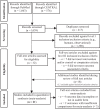Red meat consumption and risk factors for type 2 diabetes: a systematic review and meta-analysis of randomized controlled trials
- PMID: 35513448
- PMCID: PMC9908545
- DOI: 10.1038/s41430-022-01150-1
Red meat consumption and risk factors for type 2 diabetes: a systematic review and meta-analysis of randomized controlled trials
Abstract
Background and objectives: Results from observational studies suggest an association of red meat intake with risk of type 2 diabetes mellitus (T2D). However, results from randomized controlled trials (RCTs) have not clearly supported a mechanistic link between red meat intake and T2D risk factors. Therefore, a systematic review and meta-analysis were conducted on RCTs evaluating the effects of diets containing red meat (beef, pork, lamb, etc.), compared to diets with lower or no red meat, on markers of glucose homeostasis in adults.
Methods: A search of PubMed and CENTRAL yielded 21 relevant RCTs. Pooled estimates were expressed as standardized mean differences (SMDs) between the red meat intervention and the comparator intervention with less or no red meat.
Results: Compared to diets with reduced or no red meat intake, there was no significant impact of red meat intake on insulin sensitivity (SMD: -0.11; 95% CI: -0.39, 0.16), insulin resistance (SMD: 0.11; 95% CI: -0.24, 0.45), fasting glucose (SMD: 0.13; 95% CI: -0.04, 0.29), fasting insulin (SMD: 0.08; 95% CI: -0.16, 0.32), glycated hemoglobin (HbA1c; SMD: 0.10; 95% CI: -0.37, 0.58), pancreatic beta-cell function (SMD: -0.13; 95% CI: -0.37, 0.10), or glucagon-like peptide-1 (GLP-1; SMD: 0.10; 95% CI: -0.37, 0.58). Red meat intake modestly reduced postprandial glucose (SMD: -0.44; 95% CI: -0.67, -0.22; P < 0.001) compared to meals with reduced or no red meat intake. The quality of evidence was low to moderate for all outcomes.
Conclusions: The results of this meta-analysis suggest red meat intake does not impact most glycemic and insulinemic risk factors for T2D. Further investigations are needed on other markers of glucose homeostasis to better understand whether a causal relationship exists between red meat intake and risk of T2D.
Prospero registration: CRD42020176059.
© 2022. The Author(s).
Conflict of interest statement
LMS, MLW, and KCM are employees of Midwest Biomedical Research, which has received research funding from Beef Checkoff and National Pork Board.
Figures






Similar articles
-
Control interventions in randomised trials among people with mental health disorders.Cochrane Database Syst Rev. 2022 Apr 4;4(4):MR000050. doi: 10.1002/14651858.MR000050.pub2. Cochrane Database Syst Rev. 2022. PMID: 35377466 Free PMC article.
-
Aromatherapy for treatment of postoperative nausea and vomiting.Cochrane Database Syst Rev. 2018 Mar 10;3(3):CD007598. doi: 10.1002/14651858.CD007598.pub3. Cochrane Database Syst Rev. 2018. PMID: 29523018 Free PMC article.
-
Insulin and glucose-lowering agents for treating people with diabetes and chronic kidney disease.Cochrane Database Syst Rev. 2018 Sep 24;9(9):CD011798. doi: 10.1002/14651858.CD011798.pub2. Cochrane Database Syst Rev. 2018. PMID: 30246878 Free PMC article.
-
Effects of a gluten-reduced or gluten-free diet for the primary prevention of cardiovascular disease.Cochrane Database Syst Rev. 2022 Feb 24;2(2):CD013556. doi: 10.1002/14651858.CD013556.pub2. Cochrane Database Syst Rev. 2022. PMID: 35199850 Free PMC article.
-
The Effect of Dietary Glycaemic Index on Glycaemia in Patients with Type 2 Diabetes: A Systematic Review and Meta-Analysis of Randomized Controlled Trials.Nutrients. 2018 Mar 19;10(3):373. doi: 10.3390/nu10030373. Nutrients. 2018. PMID: 29562676 Free PMC article.
Cited by
-
Pork Meat Composition and Health: A Review of the Evidence.Foods. 2024 Jun 17;13(12):1905. doi: 10.3390/foods13121905. Foods. 2024. PMID: 38928846 Free PMC article. Review.
-
Silicon-Enriched Meat Ameliorates Diabetic Dyslipidemia by Improving Cholesterol, Bile Acid Metabolism and Ileal Barrier Integrity in Rats with Late-Stage Type 2 Diabetes.Int J Mol Sci. 2024 Oct 23;25(21):11405. doi: 10.3390/ijms252111405. Int J Mol Sci. 2024. PMID: 39518958 Free PMC article.
-
Umbrella Review of Systematic Reviews and Meta-Analyses on Consumption of Different Food Groups and Risk of Type 2 Diabetes Mellitus and Metabolic Syndrome.J Nutr. 2025 May;155(5):1285-1297. doi: 10.1016/j.tjnut.2025.03.021. Epub 2025 Mar 22. J Nutr. 2025. PMID: 40122387 Free PMC article.
-
Changes in Choline Metabolites and Ceramides in Response to a DASH-Style Diet in Older Adults.Nutrients. 2023 Aug 23;15(17):3687. doi: 10.3390/nu15173687. Nutrients. 2023. PMID: 37686719 Free PMC article. Clinical Trial.
-
Social, ethical, environmental, economic and technological aspects of rabbit meat production - A critical review.Heliyon. 2024 Apr 16;10(8):e29635. doi: 10.1016/j.heliyon.2024.e29635. eCollection 2024 Apr 30. Heliyon. 2024. PMID: 38699749 Free PMC article. Review.
References
-
- Zeraatkar D, Johnston BC, Bartoszko J, Cheung K, Bala MM, Valli C, et al. Effect of lower versus higher red meat intake on cardiometabolic and cancer outcomes: a systematic review of randomized trials. Ann Intern Med. 2019;171:721–31. - PubMed
Publication types
MeSH terms
Substances
LinkOut - more resources
Full Text Sources
Medical

